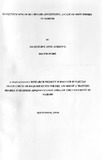| dc.description.abstract | Billboards are defined broadly as any large outdoor printed (or projected) sign. Artists’
Billboards have been a key medium or vehicle to explore and express the ideas and strategies
behind the most important art movements over the last fifty years: conceptualism and
dematerialization, temporality, appropriation and authorship issues, socio-political critique,
institutional critique, direct political engagement (defending the voices of minorities like
women, gays, blacks, different ethnicities, etc.), postmodern concerns about the difference
between reality and representation, among many others (indooradvertising.org). Billboards
are a vital means of communication especially in business. They therefore follow
communication principles to ensure effectiveness.
Effective billboards must have a clear, concise message and attractive illustrations and visual
appearance. They need to be as clutter-free as possible and easy to read. They only receive
about 2-4 seconds of a customer’s attention so the message needs to be easily digested.
Assessing the value and effectiveness of billboard advertising is challenging. There are many
methods of advertising which produce results that are easier to evaluate such as newspaper
ads and direct mail campaigns. The difference with billboard advertising is that it is exposed
to the masses but there is no real way to evaluate who really absorbs the message.
Methodologies have been applied to evaluating effectiveness, but they are weak in
demonstrating validity.
The research design employed in this study was descriptive survey research design. This
method was preferred because it allows for generalization of the research findings.
From the findings of the research, it was found that soft drink companies on average utilized
billboards for promotions. This was because they are attractive and could catch the
customer’s eye easily. On the same note it was found that the number of billboards was not
sufficient especially in rural areas. Most of the promotions utilized were found to be media
advertisements.
To enhance the effectiveness of billboards in promotion of soft drinks, the researcher
recommended that companies must follow the 7 Cs of communication: Context, Content,
Components, Cuts, Composition, Contrast and Consistency so as to come up with an
effective message that will promote the product. | en |

